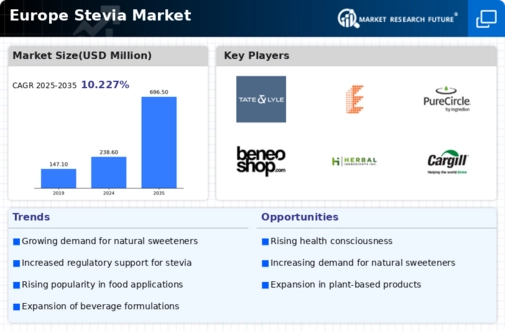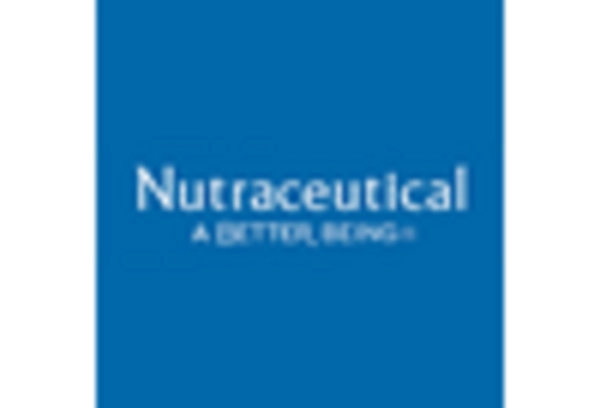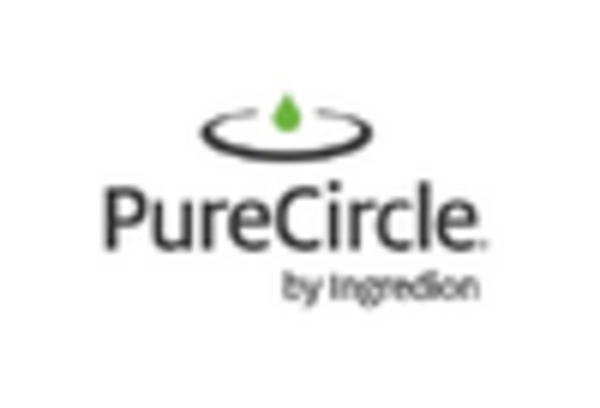Health Consciousness Among Consumers
The increasing health consciousness among consumers in Europe appears to be a pivotal driver for the stevia market. As individuals become more aware of the adverse effects of excessive sugar consumption, they are actively seeking healthier alternatives. This trend is reflected in the growing demand for natural sweeteners, with stevia emerging as a preferred choice due to its zero-calorie content and natural origin. According to recent data, the market for stevia in Europe is projected to grow at a CAGR of approximately 8% from 2025 to 2030. This shift towards healthier lifestyles is likely to bolster the stevia market, as consumers prioritize products that align with their health goals.
Rising Popularity of Low-Calorie Diets
The rising popularity of low-calorie diets in Europe is a significant driver for the stevia market. As more consumers adopt weight management strategies, the demand for low-calorie sweeteners has surged. Stevia, being a natural and calorie-free alternative, aligns perfectly with this dietary trend. Market analysis indicates that the low-calorie sweetener segment is expected to capture a substantial share of the overall sweetener market, with stevia projected to account for approximately 30% of this segment by 2030. This growing acceptance of low-calorie diets is likely to propel the stevia market forward, as consumers increasingly seek products that support their dietary preferences.
Sustainability and Environmental Concerns
Sustainability and environmental concerns are becoming increasingly relevant in Europe, influencing consumer choices and driving the stevia market. As consumers become more environmentally conscious, they are gravitating towards products that are sustainably sourced and produced. Stevia, being a plant-based sweetener that requires less land and water compared to traditional sugar production, presents a compelling option for eco-conscious consumers. This shift towards sustainability is reflected in market trends, with a projected increase in demand for stevia-based products by 25% over the next five years. The emphasis on sustainability is likely to enhance the appeal of the stevia market, as brands align their offerings with consumer values.
Regulatory Support for Natural Ingredients
Regulatory frameworks in Europe increasingly support the use of natural ingredients, which significantly impacts the stevia market. The European Food Safety Authority (EFSA) has established guidelines that favor the inclusion of natural sweeteners like stevia in food and beverage products. This regulatory backing not only enhances consumer confidence but also encourages manufacturers to innovate and incorporate stevia into their offerings. As a result, the market for stevia is expected to expand, with estimates suggesting a potential increase in market value to €500 million by 2030. This supportive regulatory environment is likely to drive the adoption of stevia across various product categories.
Innovation in Food and Beverage Formulations
Innovation in food and beverage formulations is a crucial driver for the stevia market in Europe. Manufacturers are increasingly experimenting with stevia to create new products that cater to evolving consumer preferences. This trend is evident in the rise of stevia-infused beverages, snacks, and desserts, which are gaining traction among health-conscious consumers. Market data suggests that the introduction of innovative stevia-based products could lead to a 15% increase in market penetration by 2030. As companies continue to explore the versatility of stevia, the market is likely to witness a surge in product diversity, further solidifying its position in the sweetener landscape.


















Leave a Comment